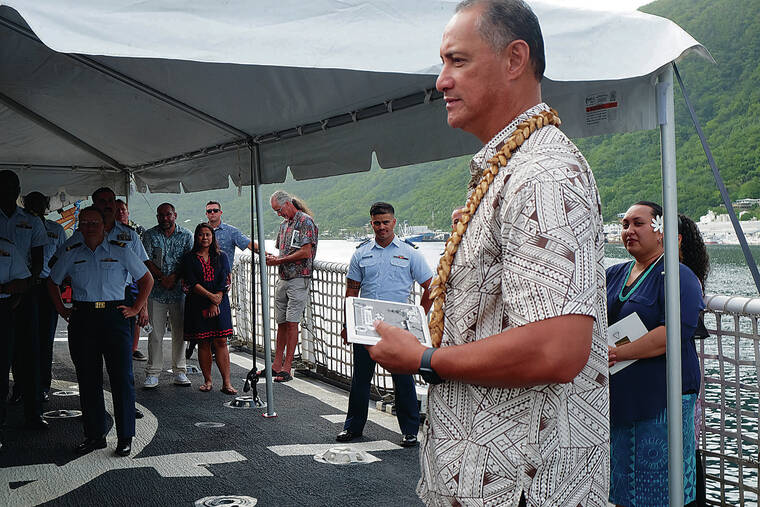
Mahalo for supporting Honolulu Star-Advertiser. Enjoy this free story!
In American Samoa, tuna is the lifeblood of the economy. Canned tuna accounts for 95.5% of all exports, and all of that tuna is canned at the StarKist Samoa cannery in Pago Pago.
After the closure of Samoa Tuna Processors in 2016, it’s now the only cannery in the territory and by itself accounts for 85% of American Samoa’s gross domestic product, according to the territory’s government. It has come to be central to how the entire territory functions as the largest single employer, and plays an outsize role in how other businesses in American Samoa work.
They rely on the ships bringing in supplies to the cannery — which otherwise would probably rarely stop in the remote islands — to also bring in goods they need, keeping shipping prices in check. And oil tankers deliver fuel both to run cannery operations and to power the territory’s electrical system.
A small fleet of fishing boats based in Pago Pago brings in the tuna to the cannery and keep it running. But as the years have gone by, tuna hauls have been getting smaller in American Samoa.
According to the Honolulu-based Western Pacific Regional Fishery Management Council, which is responsible for overseeing fisheries in America’s Pacific island territories, American Samoa’s fleet caught 5,000 metric tons of albacore tuna in 2007. But today it barely brings in more than 1,000. As the catches have dwindled, so has the fleet, from once more than 50 vessels to now just 27.
The council, along with fishermen and officials in the island territory, blame the decrease on a massive increase in Chinese-operated fishing vessels in the region. In 2007 there were about 100 Chinese-flagged vessels in the Pacific island region, and today there are now more than 540 that are active in the waters around American Samoa.
China is the world’s largest consumer and exporter of seafood, and its massive state-subsidized fishing fleet — the world’s largest — has been accused of widespread overfishing around the globe.
“This is directly related to the increase in China’s fishing effort,” said Archie Solial, the territory’s director of marine wildlife resources. He said that the Chinese presence is even larger than it appears on paper, with many Chinese companies registering vessels to Pacific island countries, a practice known as using “flags of convenience.”
“They can do almost anything that they want to do without much accountability,” said Solial.
In 2020 the Coast Guard declared that illegal, unreported and unregulated fishing — or IUU — had surpassed piracy as the No. 1 global security threat at sea. In October of that year, then-White House National Security Adviser Robert O’Brien announced that the Coast Guard would beef up its presence in the region and launch a $5 million study to look at stationing a ship in Pago Pago and adding new ones in Guam in an effort to combat overfishing, particularly by China’s fleet.
“This will be quite an expansion of our U.S. Coast Guard capability in the Western Pacific,” O’Brien told reporters across the region in a conference call at the time. “This capability will allow us to expand opportunities to partner with like-minded nations in the region.”
But ultimately, while the Coast Guard has increased its presence and stepped up operations in the region, the study concluded that American Samoa lacked the infrastructure to host a vessel. American Samoan officials say that has left them exposed as the Chinese fleet continues making inroads in neighboring island countries.
Lack of resources
American Samoa was once home to a major U.S. Navy presence and was under military administration until 1951, when Naval Station Tutuila shut down. When the harbor that once housed warships transitioned to commercial use, the tuna industry quickly set up shop. The Coast Guard also set up a small station, but by the 1980s it was shuttered and today the service only maintains a small administrative office in Pago Pago and no vessels or aircraft.
Even so, the island territory is still deeply tied to the U.S. military. It has the highest enlistment rate of anywhere in the United States. But though many in American Samoa consider themselves patriotic and proud of family members’ military service, to many the military is first and foremost a ticket out of the island territory. More than half of families in American Samoa live below the poverty line.
“It’s nothing really to brag about, but unfortunately, there’s not that many opportunities,” said Solial. “The few opportunities that we do have we should continue to try to salvage as best we can, and the cannery being the only economic driver, the main economic driver, is a key concern.”
Coast Guard vessels and planes stationed in Hawaii regularly visit American Samoa to conduct patrols, but Solial said American Samoa Gov. Lemanu Palepoi Mauga and previous governors have been pushing for a permanent presence to protect the territory’s waters and provide on call search-and-rescue resources.
“The response that we’ve gotten is we don’t have the resources or the infrastructure here,” said Solial.
“The Coast Guard’s resource constraints are a persistent problem across the service, and especially affects more far-flung communities where it is difficult to maintain economies of scale with a continuous presence,” said U.S. Rep. Ed Case. “Adequate infrastructure and security for our Neighbor Island and Pacific communities is a larger issue that also extends beyond the Coast Guard.”
Case added, “If we cannot homeport our larger cutters which are especially suited to high seas and exclusive economic zone IUU fishing enforcement in these locations, it is important for us to assure a full complement of personnel and equipment out of Honolulu to both take care of Hawaii’s needs and maintain a consistent presence elsewhere in the Pacific.”
Recently the Coast Guard assigned the CGC Harriet Lane, a 270-foot medium-endurance cutter with a crew of just under 100, to Honolulu as the “Indo-Pacific Support Cutter” dedicated to operations across Oceania.
It’s currently on its first deployment in that new role and is expected to deploy across the region frequently, with fishery enforcement top priority. Pago Pago was the Lane’s first stop on the deployment, making a several- day port call at the beginning of February after fishery enforcement operations on the high seas, and continued onto the Independent State of Samoa for a joint patrol with local authorities.
But in American Samoa, local officials have pushed for stationing a Fast Response Cutter, a 154-foot vessel manned by a crew of just 24 people, in the territory. Since 2020 the Coast Guard has stationed three in Guam to support operations in Micronesia. Solial said “they’re fairly small, and that’s all we need,” and noted that the lack of support is particularly frustrating given that both the Navy and Coast Guard were able to maintain bases and port vessels in Pago Pago in the past.
“I think it’s hypocritical of (the federal government) to say that we need to increase our presence in the Pacific, and then you’ve got a U.S. territory that’s right in the middle of the most prolific fishing grounds in the world,” said Solial. “It’s very hypocritical and a slap in the face that they may tell us that they want to increase efforts to combat IUU, and at the same time, not spend the resources we’re talking about.”
Fishing for influence
Fishing rights have long been central to the politics of the Pacific islands. Many countries in Oceania rely on fishing charters and licenses to foreign fishermen as a critical source of income for their economies. At its peak the American Samoa fleet was a major player in the South Pacific.
But the Chinese government has sought to expand its influence in the region, as well as its share of the fishing industry. In 2014 China secured the right to fish in Kiribati, and Chinese companies began buying up permits en masse and quickly began elbowing out the U.S. fleet. Since then Kiribati has reduced the fishing time it had allotted to the U.S. fleet to a level that American fishermen deemed not worth the effort.
China has worked to build up influence in the Pacific, bringing several countries into its Belt and Road Initiative — a series of Chinese government-funded construction and infrastructure projects around the globe. In the Pacific, that includes ports to support Chinese vessels and seafood processing plants.
“They’re building ports, they’re building wharfs, fishery development projects, they’ve been talking about a major project next door in Apia (Samoa), which is a major concern for us,” said Solial. He added that when he compares U.S. investment in the Pacific, “if you do the math, you know, split it up with 19 countries, it’s not that much compared to what China is investing in each area that they have interests in.”
In 2021 Kiribati opened up the Phoenix Islands Protected Area, once one of the the world’s largest marine life sanctuaries, to Chinese fishing companies.
Rick Gaffney, a Hawaii fisherman and environmentalist with the Pacific Remote Islands Coalition, said, “One of the reasons I think we need to be concerned is that China has effectively wiped out any reasonable semblance of a productive fishery in their home waters, and they did that by absolutely rapacious fishing methods. … Basically, they don’t seem to have the same concerns that we have about eliminating species or entire populations.”
Gaffney said that for years top U.S. officials have paid little attention to Pacific island countries and overlooked the threats posed by overfishing,
“America has basically punted, but I think that we’re beginning to realize that there are huge national security issues as well,” he explained. “The Chinese are building bases that are ostensibly for moving fish from the fishing boats wherever they are in the Pacific back to the Chinese mainland. So they’re taking atolls, turning them into large landing strips with deep-water ports. And that’s going to give them a huge advantage, if there ever are any altercations between us — or anyone else — and the Chinese.”
In late February the Harriet Lane sailed to Vanuatu, another country in the Belt and Road Initiative where China has invested heavily in fisheries. Members of the Vanuatu police and U.S. Coast Guardsmen operating from the Lane boarded several boats and found that six Chinese vessels were violating local laws, including failing to record fish caught in their logbooks.
Vanuatu, like many Pacific island nations, does not have a navy or coast guard of its own and has limited resources to protect its own waters. The Lane’s visit offered Vanuatu officials their first opportunity in years to actually inspect Chinese vessels actively fishing in their waters.
But when it comes to international fishery violations, it’s up to the flag state to make fishing-vessel owners and operators pay fines and administer punishments. The Chinese Embassy in Vanuatu told Reuters the boats had fishing permits from Vanuatu’s government and that no crimes had occurred because “Chinese companies obey Vanuatu laws.”
Solial said that dynamic means there’s often little actual enforcement when it comes to ships from foreign distance-fishing fleets, which in addition to flouting environmental regulations also have been accused of widespread labor abuse of crews. Some crew members are kept on boats well beyond their contracts, spending months or even years trapped at sea.
“If we’re serious about IUU, let’s do something about it,” said Solial. “If we’re serious about it — labor rights, human rights — do something about it. And I think the U.S. is in a prime position to to make those changes.”
Read More: World News | Entertainment News | Celeb News
Star Ads






